The Other Side of Mindset
By Dr. Robert Biswas-Diener

Research on the so-called “mindset” has become so popular that it is influencing classrooms, corporate workshops, and coaching conversations. Here are two often-overlooked ideas about mindset.
Introduction
It seems that every month, a new management bestseller hits the shelves. One title promotes lean business practices, and another emphasizes agility. One is about emotional intelligence, and another is about strengths. In part, I have always suspected that these titles are popular because they insert fresh ideas into organizational work. They don’t pretend to offer the final word on effective business practices; they just provide inspiration and a few practical tools.
My world—psychology—is not so different. If you look at the most popular books to emerge from my field, you will see some big ideas: persuasion, happiness, grit. One of these is “mindset,” the idea that people with a certain type of mindset are more likely to be successful. Dr. Carol Dweck, at Stanford University, has researched this topic for decades and has written a perennially bestselling book on the topic. Her message has been so successful that it influences educators, managers, parents, and coaches.
Like many popularized big ideas, however, there are nuanced angles to mindset. Sure, people with a “growth mindset” tend to perform well. Even so, this concept has been trotted out as a cure-all. For instance, I have heard parents question how they can change their child’s mindset without ever questioning whether they should. It turns out that, as beneficial as a growth mindset is, there are reasons to be cautious.
A Quick Primer on Mindset
You might not be aware of the mindset research. If so, let me bring you up to speed in a single paragraph. Simply put, researchers have categorized mindsets into two camps: “fixed” and “growth.” Those with a fixed mindset believe that their personality and abilities are relatively fixed in place. They believe, for example, that some people are “born artistic” and others are not. By contrast, those with a growth mindset are more likely to see these types of qualities as something a person can develop through practice. Certainly, we can all agree that there are some individual differences in inborn talent, but even this must be cultivated through effort. Those with a growth mindset tend to show superior performance. They are more likely to see a challenge as an opportunity and more likely to see mistakes as moments of learning rather than as a threat to their own intelligence.
A Hidden History of Mindset

I first learned about Marty Seligman’s 1968 research on “learned helplessness” as a child, while driving across town in our family’s hulking station wagon. I come from a family of psychologists, and it was not uncommon to discuss science even when we were very young. My mother, who was in graduate school at the time, was keen to link Seligman’s research with dogs to humans. She explained that when dogs (or people) perceive that they cannot overcome failure, they simply give up. This makes sense: why bother putting out energy if you will almost certainly fail!
My mother presented an intriguing and familiar example: under-achieving children. “Underachievers,” as they are pejoratively known, are smart kids who do not perform well in school. They should–after all, they are bright—but they don’t. Researchers were curious as to what was going on with these kids. Was it laziness? Or, might it be something else? Something related to the process of learned helplessness. To investigate this, they recruited children for a series of studies, some of whom had a “helpless orientation” and others who had a “mastery orientation.” The researchers, one of whom was Carol Dweck, had the children solve problems and then either interviewed them about moments of failure or had the children “think out loud” as they were struggling with the problems. They found That half of the helpless-oriented kids said: “I am not smart enough.” None of the mastery-oriented children blamed their own intelligence. Instead, they were likely to chalk their failure up to “bad luck,” “unfairness,” “tough problems,” or a lack of sufficient effort.
The researchers also follow-up with another study: using the same type of problem-solving tasks, the scientists were curious how helpless and mastery-oriented children would respond to success. The first problems were relatively easy, and members of both groups were pleased with their own successful performance. Despite their equal performance, however, the mastery-oriented children were more optimistic that they would perform well on subsequent puzzles (they hoped to get 90% correct, whereas their helpless-oriented peers doubted that they could successfully complete more than 50%). In both studies, the Dweck team found that how a person reacts to success and failure is a critical aspect of mindset. People who think they are continuing to develop are more likely to see success and failure as an important part of that development process.
What I like best about this often-overlooked research from the late 1970s is that the first author on both publications was my mom. She worked with Carol Dweck, and these studies formed the seed of the growth mindset research that came later. On a minor, personal note, Carol Dweck used to use me—when I was a toddler—to demonstrate the Piagetian developmental stages to her undergraduate psychology classes. She recently told me that I “stole the show,” but I have to be careful to believe that my showmanship is not fixed but something to be developed!
The Other Side of Mindset: Your Weaknesses

Here’s the problem: people read about the two types of mindset, and they walk away with a simple take-home message: growth mindset is the good one, and fixed mindset is the bad one. Following this reasoning, they try to figure out how they can adopt a growth mindset. Easier said than done. Let me illustrate: I enjoyed drawing when I was a kid, but once I became an adult, the duties of work and raising children caused me to cast aside this past-time. Then, in my mid-40s, I decided to take it up. Here is a picture I drew a year after starting up again. It’s not as good as a professional artist, but it is competent for a beginning hobbyist. Let me pose this question to you: could you draw something like this?
Talented and artistic people will be quick to answer in the affirmative, but most other people shake their heads in dismay. The most radical view of a growth mindset, however, would suggest that you can. After all, you can develop through practice. This example highlights how natural talent, personal interest, motivation, perseverance, and other factors play into the mindset equation.
Carol Dweck is quick to point this out. There are time and effort costs associated with developing an ability. We often have to pick and choose. Should you try to adopt a growth mindset in which you believe you can become an ace pilot, a master sculptor, an excellent chef, a proficient copy-editor, and a daring skier? Probably not. If you had unlimited time and money, you could undoubtedly improve at each, but you would likely see more improvement in some areas than others. That is, a little natural talent and interest will likely aid your development even if you have a growth mindset.
Which brings us to the question of developing strengths versus weaknesses. Again, a radical view of a growth mindset might suggest that a person should be able to develop their strengths and weaknesses in equal measure, given equal effort. Results from research, however, suggest that people don’t believe this. Instead, people are more likely to believe that they can improve on their weaknesses and that their strengths are relatively fixed. This is because this way of thinking is good for our self-esteem. It feels good to “know” that you can fixedly count on your strengths but also that you can dispatch those pesky weaknesses through effort.
The problem with this intuitive line of reasoning is that people may miss opportunities to develop their best qualities while simultaneously banging their head against a ceiling regarding the development of their weaknesses. Admittedly, the research on this issue is relatively small. Even so, studies by the Gallup Organization reveal better performance when managers focus on cultivating their supervisees’ strengths. This is not to say that people ought to ignore their weaknesses or that they cannot improve on their weaknesses. Instead, it is a reminder that one’s strengths might very well be an excellent area for development.
The Other Side of Mindset: Finding Your Passion

The concept of mindset also bears on the common idea of “finding your passion.” In Western societies, especially, people hope to stumble upon their calling, discover their heart’s desire, and meet their soulmate. It should be noted that all three of these examples are a fixed mindset. The growth mindset alternative would suggest that you develop—not find—a passion.
This is exactly the distinction that a team of researchers—including Dweck– investigated. Across five studies, they examined the consequences of having each of the two mindsets with regards to one’s passion. They discovered that people with a more fixed mindset had fewer interests. The fixed-mindset crowd was also more likely to assume that a passion will come with limitless motivation. However, when their motivation waned, people with a fixed mindset were more likely to assume the activity was not a true passion and to discontinue it. By contrast, those with a growth mindset were more likely to anticipate challenges in their areas of interest and to accept and enjoy the process of learning.
Conclusion
Mindset is a perfect illustration of the benefits and perils of “popular science.” The research on this topic has yielded useful insights. The distinction between growth and fixed mindset offers us all a helpful way to think about our own development and to better understand our reactions to success and failure. Mindset research is also nuanced, and many of the findings go well beyond the growth-is-good-and-fixed-is-bad attitude. To better apply this topic to your own life, consider the following questions:
- Which of my abilities do I believe I can develop and which do I see as relatively stable?
- How much would it cost me to develop a particular area in terms of time and effort? Is that cost worth it to me?
- How can I remind myself that self-development is a process rather than a destination? How can I accept occasional failure or shifts in motivation?
- Which skills am I trying to master versus which might just be fun to try?

About the author
Dr. Robert Biswas-Diener
Dr. Robert Biswas-Diener is passionate about leaving the research laboratory and working in the field. His studies have taken him to such far-flung places as Greenland, India, Kenya, and Israel. He is a leading authority on strengths, culture, courage, and happiness and is known for his pioneering work in the application of positive psychology to coaching.
Robert has authored more than 70 peer-reviewed academic articles and chapters, two of which are “citation classics” (cited more than 1,000 times each). Dr. Biswas-Diener has authored seven books, including the 2007 PROSE Award winner, Happiness, the New York Times Best Seller, The Upside of Your Dark Side, and the 2023 book Positive Provocation.
Robert Biswas-Diener

Get updates and exclusive resources



